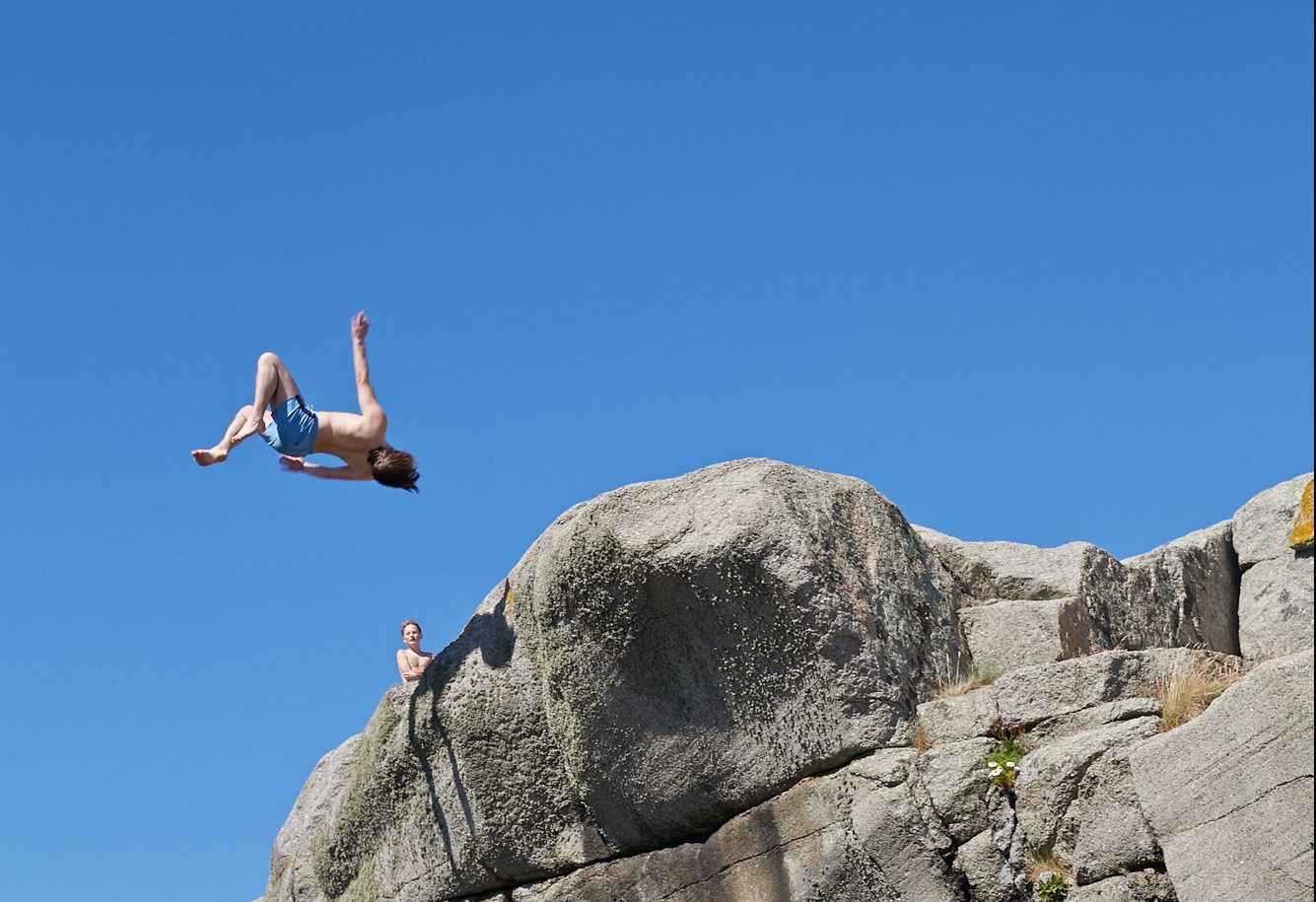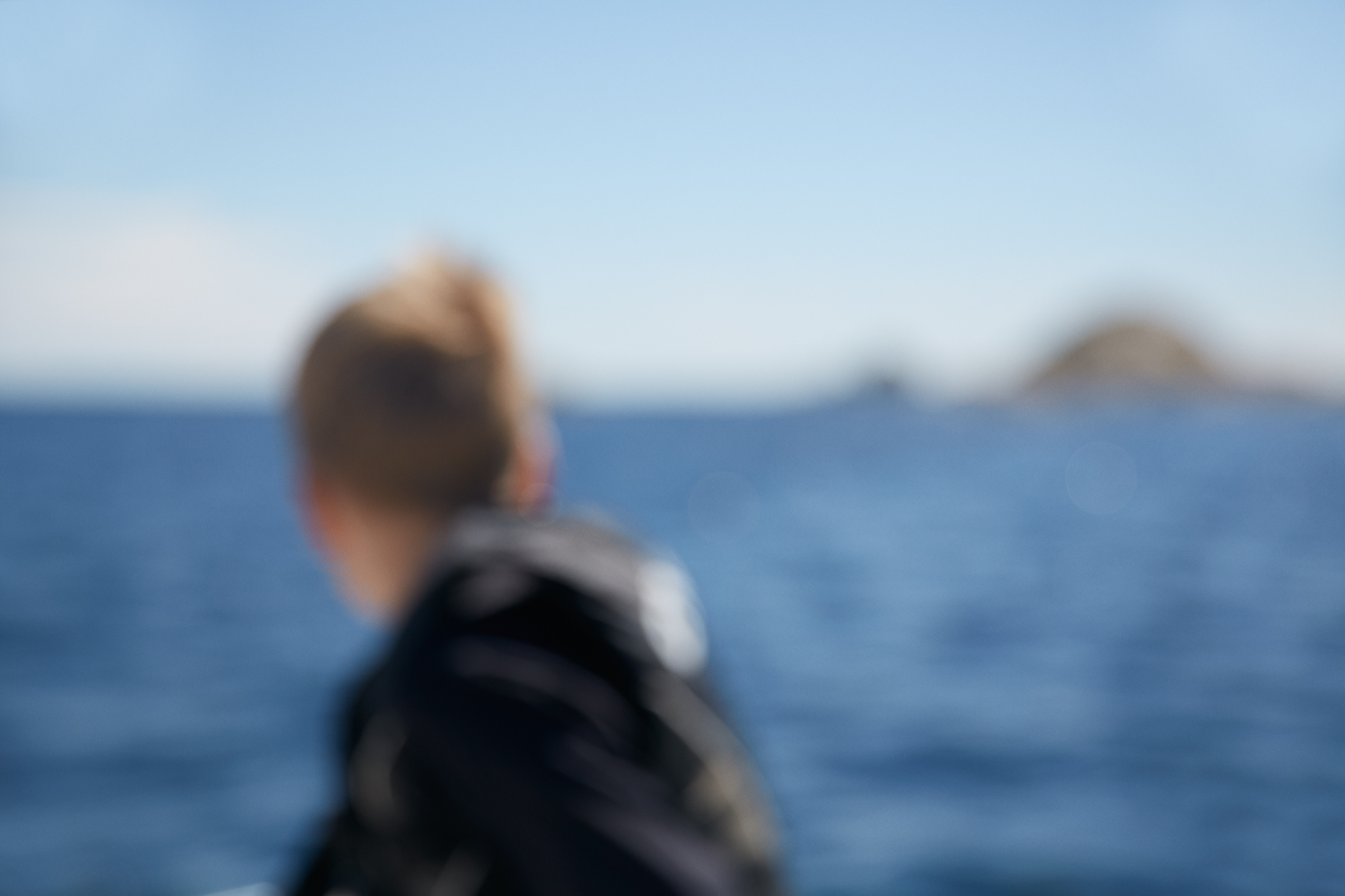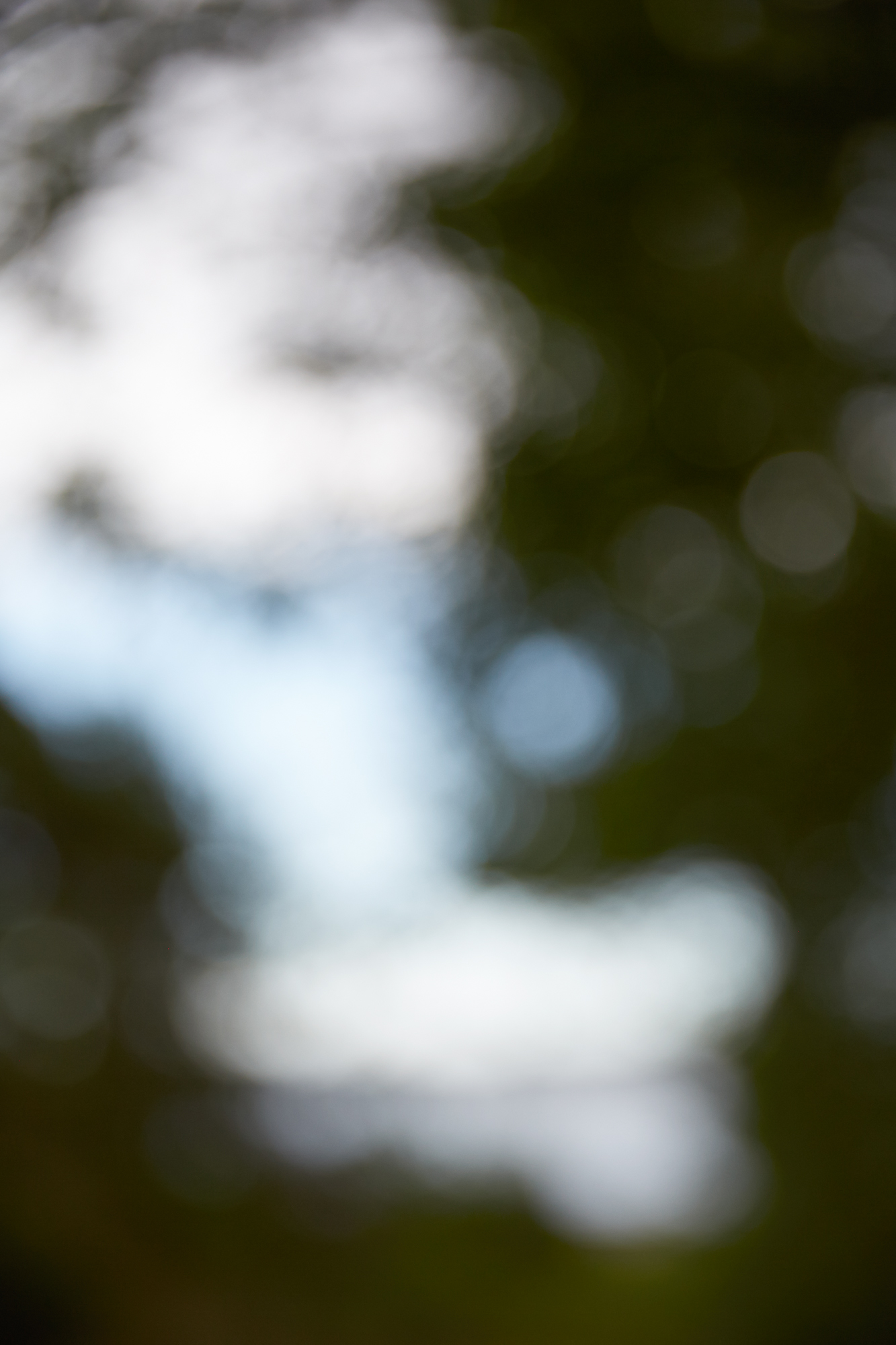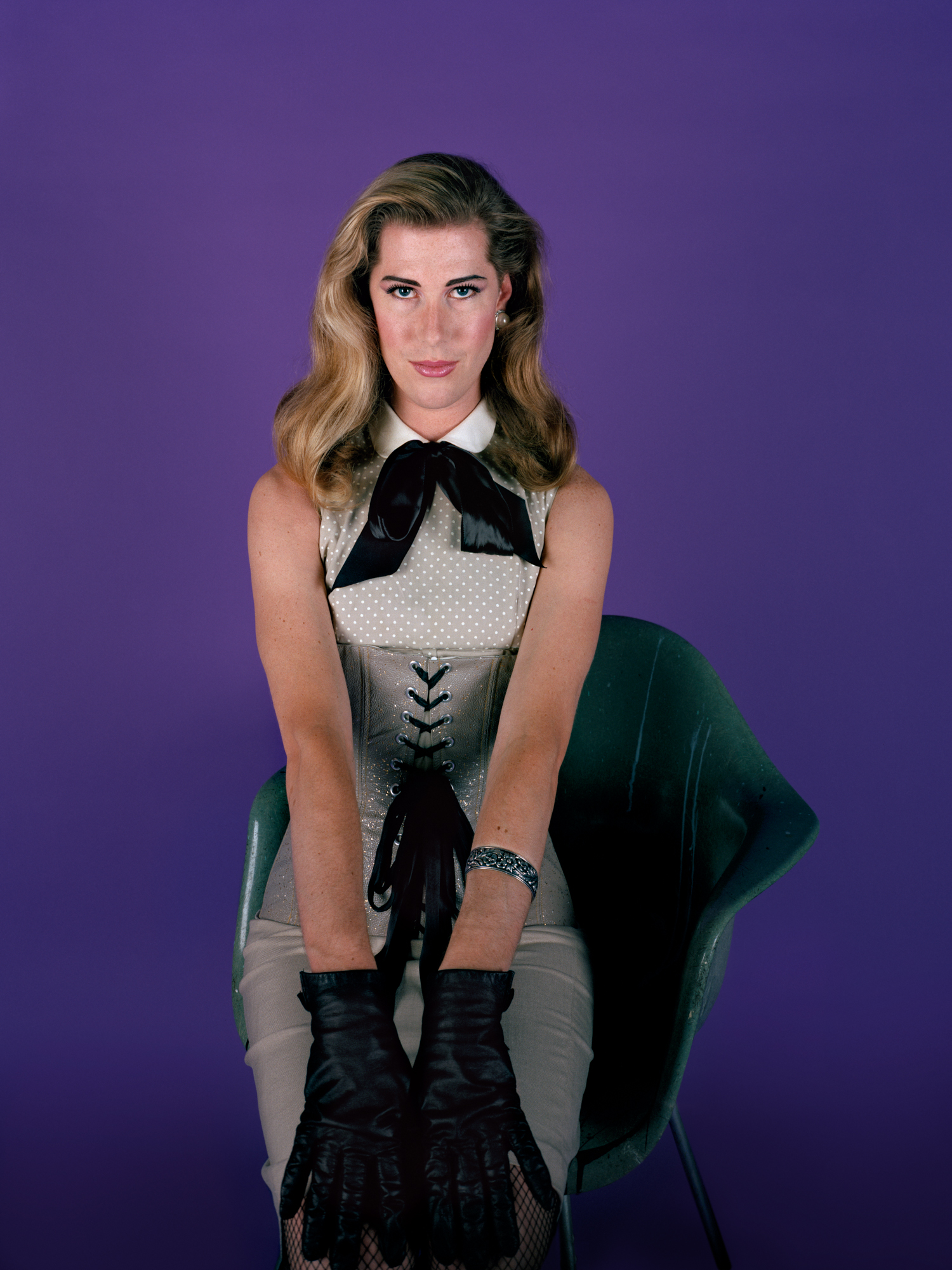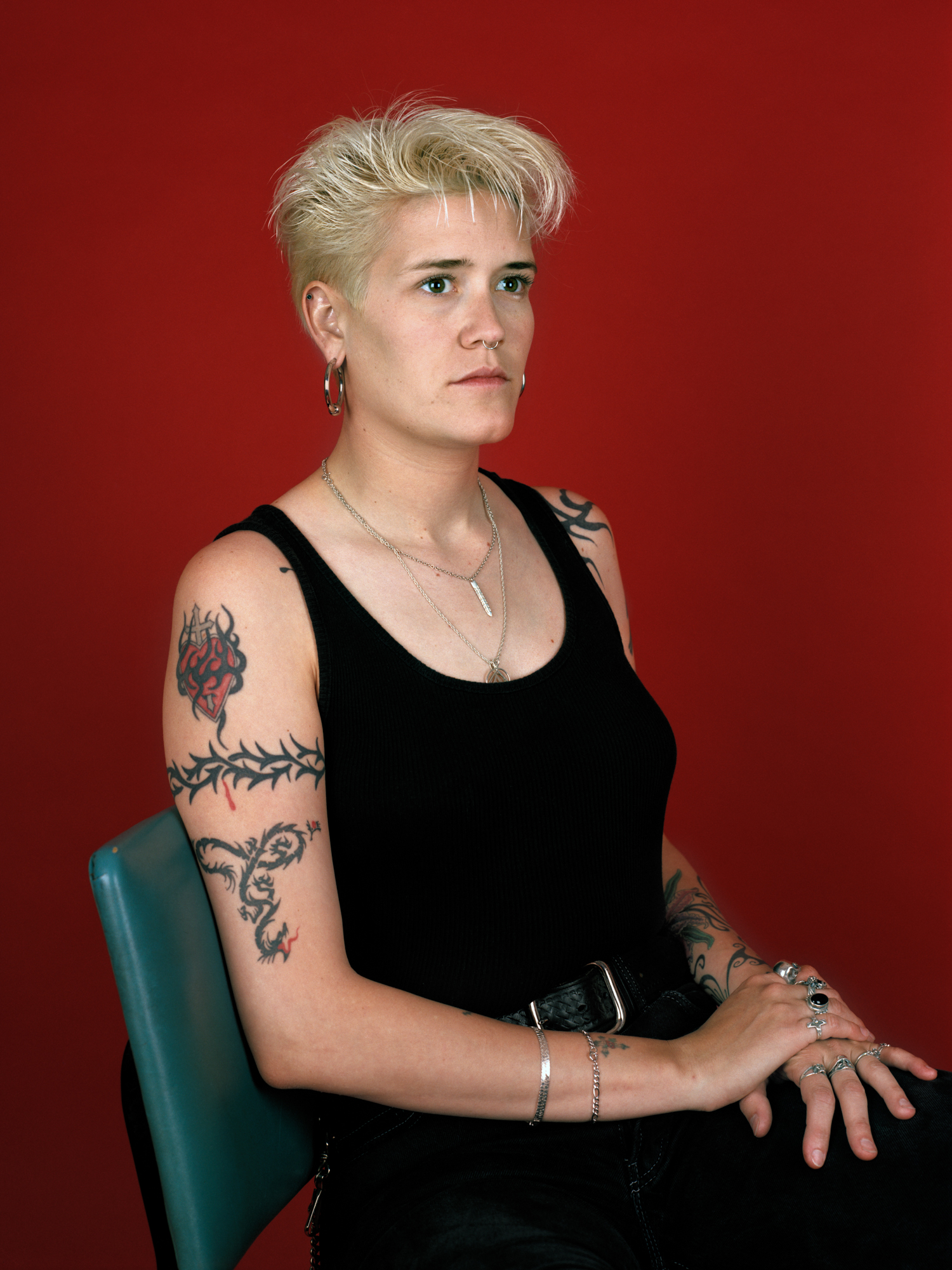
Features #14 — December 2022
Catherine Opie in conversation with Nicolas Vamvouklis
Catherine, I’d like to start with your recent exhibition “To What We Think We Remember” at the Thomas Dane Gallery in London, presenting works made over the last ten years on journeys across the United States and Europe. I couldn’t stop looking at two photographs: the intimate family portrait “Joyce, Jon, Mo and Kuini” and the performative “Fjord flip, Norway.” This pairing was a constant reminder of the relationship between our collective responsibilities and our personal, political freedoms. What have you learned from these ‘social documentary’ travels?
That’s an interesting question; I think you read it correctly. There is this family in New Zealand. Joyce was from New Zealand, and then Jon joined her with a lawyer from Los Angeles. They were living in the country and trying to raise chickens and their kids in a different way than in LA. This photo relates to collectivity, while the “Fjord flip, Norway” was absolutely about freedom. I think with this specific exhibition versus digging deep and kind of a documentary language that I dip into quite a bit throughout all of my life. I wanted to set up a more metaphorical relationship with each other to the times that we’re living in, not only here in the United States but that there is globally something that we are fighting for in terms of democracy. All of that affects how I consider work and power structures and begin to disseminate these little gestures in relation to that larger notion of humanity and collectivity.
Speaking of domesticity, I am trying to imagine your studio. I’m sure you have many books, and I know you own a Garfield stuffed animal. What does your working space actually look like?
Right now, it’s a little chaotic because I never really meant to live in my studio. Everything is here now because I’m going through a divorce. So there are too many piles of things. I think I’m a sentimental person and even the London exhibition shows that sentimentality to a certain extent. I have a hard time getting rid of things, it seems. But, it’s very comfortable here; I mean, it’s a very big, functioning studio in terms of making and producing. The home/living space is starting to actually feel more like a home and living after almost a year of being here.
Let’s pass to the digital sphere — you are pretty active on social media, and I admit I love your big smile in all your selfies. In which ways do you relate to these platforms, and how do you feel about the dissemination of photography in the media today?
That’s a big question — the dissemination of photography in the media. So many people have asked me: “don’t you think there are too many pictures now, Cathy?”. I don’t think there are too many; it’s more about what you do with the pictures. It’s funny that you say this because I believe I’m horrible at social media. I know the younger artists post every show that they are in. They use the platforms to push their work out, and I think that minor is more like little moments of thought when I suddenly consider posting something to Instagram or I like to be funny. In some ways, my sense of humor doesn’t necessarily come through the bodies of work, but I feel social media shows that I have a sense of humor and warmth as a person. I assume that’s a nice addition to my personality you might not see by going to an exhibition.
I’m going through your Instagram account right now; the feeling is very homey. There is a post from 2018 with the slogan “I DON’T CARE” over a portrait. I’m not sure about the context, but I like the first comment, which responds “Yes, you do!”. There is currently an extensive discussion about the wider notion of care. What is the first thing that comes to your mind when you hear this word?
Well, care is really important; I mean care with everything. I would say that I’m not a careful but a caring person who utterly believes in humanity. I wrote “I DON’T CARE” in response to Melania’s jacket featuring the same message during her visit to see the devastation. I was probably having a little political poke in that Instagram post. But even when I teach, the idea of caring for the students, along with criticality and being able to be helpful — because I believe caring is helpfulness too. I don’t think we were necessarily very helpful to one another in society these days, and it’s completely troublesome that I tried to lead my life with a lot of care.
I’m also thinking about the relationship of care with the economies of ‘happiness’ in the arts. How can creativity act as a healing force for art professionals and their audiences through such a difficult period?
There are so many different ways. Art is just incredibly elastic in relationship to meaning. You can create things that all of a sudden people are in all over. You can create pauses which I talk about within my practice when I might put a challenging image, and then you get to ponder and think about the next image. For instance, I did a show in Korea this summer. I used the earlier queer portraits in the below gallery space, where I did all horizon lines of my journey from Korea to the Port of Long Beach in a new configuration to talk about equality. You could go upstairs and contemplate this moment of being surrounded by these seas that automatically balance you out while facing a queer body. North Korea doesn’t have any rights at all, but when I was there lecturing in South Korea, they were like: “we only have one alley we hang out in, all of us gay people.” I replied: “maybe you need to start going to other alleys.” But I think there are so many ways you can make work that operates on all the different levels of experiences we have as human beings. I try to have the work reflect those quandaries; because they are quandaries to me. They are propositions, especially the show that I did in London was a proposition.
You joined the UCLA Department of Art faculty in 2001, teaching photography, and you were appointed departmental chair last year. How do you approach teaching, and what advice would you give a young artist at the start of their career?
To young artists at the start of their careers, I always give the exact same advice that I’ve given over thirty years of teaching. That is to be curious, to answer your questions in your own mind with your work. Be aware of history, art history, and contemporary art history because those dialogues that interact with what you’re trying to create are important in ensuring that your work is unique to yourself and your experience within making work. The other thing is perseverance; the reason why you’re an artist is just that this is your language. You might not get anywhere, but eventually, you will get somewhere with it anyway. Because I don’t believe in the middle of nowhere; I don’t believe in those kinds of statements. I acknowledge that you must be completely invested and passionate about your practice. You have to give time to do it, which is really hard. I have had a full-time job since I was fifteen years old. I have been able to make work on an international level as well as have a full-time, dedicated profession as an educator. It’s completely balanced because even if there’s an enormous amount of work, it is all about passion and curiosity. I’m happy to sit with young people and be helpful to them concerning what they’re making and how to advance their thinking around their work. It’s a symbiotic relationship in some ways, but I’m looking forward to just being an artist.
Catherine Opie
Photo Credit
Catherine Opie, Joyce, Jon, Mo and Kuini, 2011, Pigment print, 76.2 x 86.4 cm © Catherine Opie. Courtesy of the artist, Thomas Dane Gallery and Regen Projects, Los Angeles.
Catherine Opie, Fjord flip, Norway, 2014, Pigment print, 127 x 84.6 cm © Catherine Opie. Courtesy of the artist, Thomas Dane Gallery and Regen Projects, Los Angeles.
Catherine Opie, Herman, Norway, 2014, Pigment print, 127 x 84.6 cm © Catherine Opie. Courtesy of the artist, Thomas Dane Gallery and Regen Projects, Los Angeles.
Catherine Opie, Breathe, 2014, Pigment print, 127 x 84.6 cm © Catherine Opie. Courtesy of the artist, Thomas Dane Gallery and Regen Projects, Los Angeles.
Catherine Opie, Justin Bond, 1993, C-print, 101.6 x 76.2 cm © Catherine Opie. Courtesy of the artist, Thomas Dane Gallery, Lehmann Maupin, and Regen Projects, Los Angeles.
Catherine Opie, Crystal Cross, 1989, C-print, 101.6 x 76.2 cm © Catherine Opie. Courtesy of the artist, Thomas Dane Gallery, Lehmann Maupin, and Regen Projects, Los Angeles.
Catherine Opie, Untitled #6 (From Your Shore to My Shore), 2009, Pigment print, 109.2 x 81.9 cm © Catherine Opie. Courtesy of the artist, Thomas Dane Gallery, Lehmann Maupin, and Regen Projects, Los Angeles.
Catherine Opie, Untitled #12 (From Your Shore to My Shore), 2009, Pigment print, 109.2 x 81.9 cm © Catherine Opie. Courtesy of the artist, Thomas Dane Gallery, Lehmann Maupin, and Regen Projects, Los Angeles.
BIO
Catherine Opie is an American artist and educator. Her work has been exhibited worldwide and is well known for her portraits exploring her San Francisco and Los Angeles community. At the core of Opie’s practice is an investigation into how photographs both document and give voice to social phenomena, registering people’s attitudes and relationships to themselves and others, and the ways in which they occupy the landscape. She received numerous awards, including The Guggenheim Fellowship (2019) and The Smithsonian’s Archives of American Art Medal (2016). Opie is the Lynda and Stewart Resnick Endowed Chair in Art and Professor of Photography at UCLA.
Catherine Opie
Photo Credit
Catherine Opie, Joyce, Jon, Mo and Kuini, 2011, Pigment print, 76.2 x 86.4 cm © Catherine Opie. Courtesy of the artist, Thomas Dane Gallery and Regen Projects, Los Angeles.
Catherine Opie, Fjord flip, Norway, 2014, Pigment print, 127 x 84.6 cm © Catherine Opie. Courtesy of the artist, Thomas Dane Gallery and Regen Projects, Los Angeles.
Catherine Opie, Herman, Norway, 2014, Pigment print, 127 x 84.6 cm © Catherine Opie. Courtesy of the artist, Thomas Dane Gallery and Regen Projects, Los Angeles.
Catherine Opie, Breathe, 2014, Pigment print, 127 x 84.6 cm © Catherine Opie. Courtesy of the artist, Thomas Dane Gallery and Regen Projects, Los Angeles.
Catherine Opie, Justin Bond, 1993, C-print, 101.6 x 76.2 cm © Catherine Opie. Courtesy of the artist, Thomas Dane Gallery, Lehmann Maupin, and Regen Projects, Los Angeles.
Catherine Opie, Crystal Cross, 1989, C-print, 101.6 x 76.2 cm © Catherine Opie. Courtesy of the artist, Thomas Dane Gallery, Lehmann Maupin, and Regen Projects, Los Angeles.
Catherine Opie, Untitled #6 (From Your Shore to My Shore), 2009, Pigment print, 109.2 x 81.9 cm © Catherine Opie. Courtesy of the artist, Thomas Dane Gallery, Lehmann Maupin, and Regen Projects, Los Angeles.
Catherine Opie, Untitled #12 (From Your Shore to My Shore), 2009, Pigment print, 109.2 x 81.9 cm © Catherine Opie. Courtesy of the artist, Thomas Dane Gallery, Lehmann Maupin, and Regen Projects, Los Angeles.























